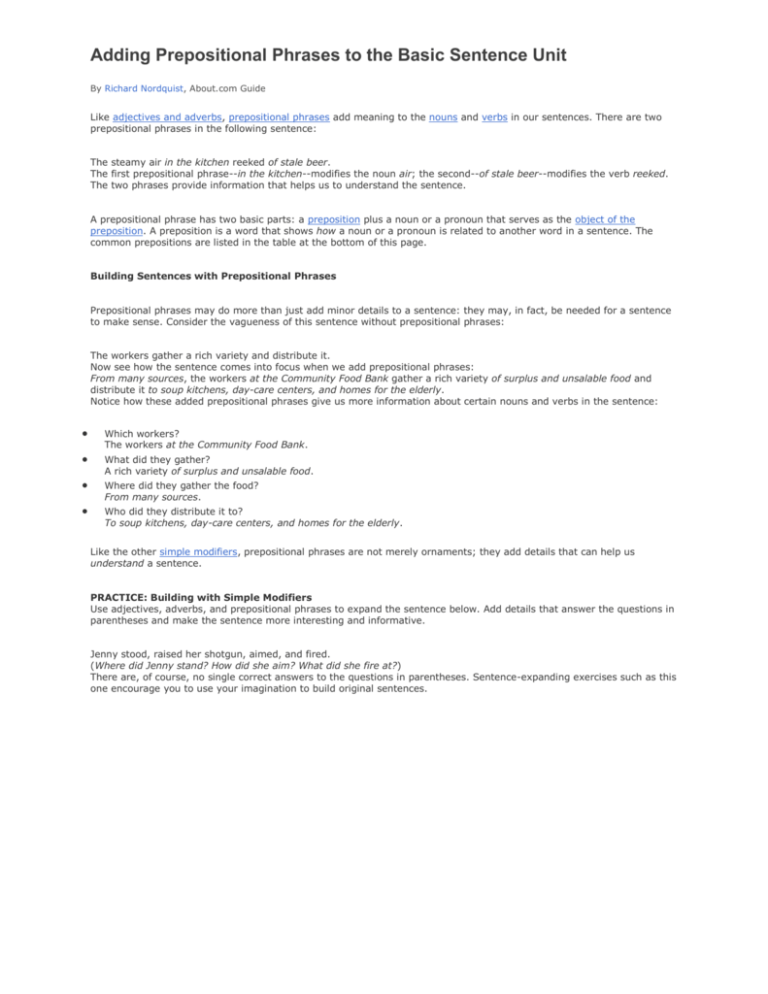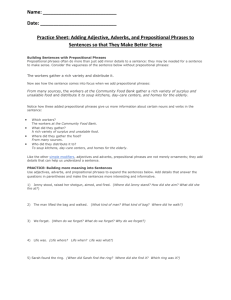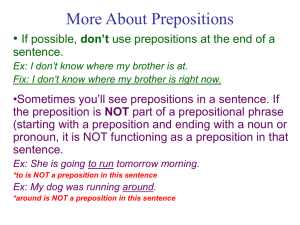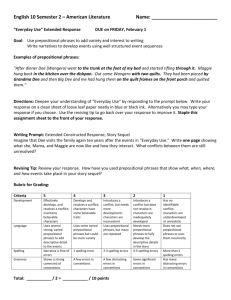Prepositional Phrases Worksheet
advertisement

Adding Prepositional Phrases to the Basic Sentence Unit By Richard Nordquist, About.com Guide Like adjectives and adverbs, prepositional phrases add meaning to the nouns and verbs in our sentences. There are two prepositional phrases in the following sentence: The steamy air in the kitchen reeked of stale beer. The first prepositional phrase--in the kitchen--modifies the noun air; the second--of stale beer--modifies the verb reeked. The two phrases provide information that helps us to understand the sentence. A prepositional phrase has two basic parts: a preposition plus a noun or a pronoun that serves as the object of the preposition. A preposition is a word that shows how a noun or a pronoun is related to another word in a sentence. The common prepositions are listed in the table at the bottom of this page. Building Sentences with Prepositional Phrases Prepositional phrases may do more than just add minor details to a sentence: they may, in fact, be needed for a sentence to make sense. Consider the vagueness of this sentence without prepositional phrases: The workers gather a rich variety and distribute it. Now see how the sentence comes into focus when we add prepositional phrases: From many sources, the workers at the Community Food Bank gather a rich variety of surplus and unsalable food and distribute it to soup kitchens, day-care centers, and homes for the elderly. Notice how these added prepositional phrases give us more information about certain nouns and verbs in the sentence: Which workers? The workers at the Community Food Bank. What did they gather? A rich variety of surplus and unsalable food. Where did they gather the food? From many sources. Who did they distribute it to? To soup kitchens, day-care centers, and homes for the elderly. Like the other simple modifiers, prepositional phrases are not merely ornaments; they add details that can help us understand a sentence. PRACTICE: Building with Simple Modifiers Use adjectives, adverbs, and prepositional phrases to expand the sentence below. Add details that answer the questions in parentheses and make the sentence more interesting and informative. Jenny stood, raised her shotgun, aimed, and fired. (Where did Jenny stand? How did she aim? What did she fire at?) There are, of course, no single correct answers to the questions in parentheses. Sentence-expanding exercises such as this one encourage you to use your imagination to build original sentences. Expanding Sentences With Prepositional Phrases 1. Instructions: Expand each sentence below by adding one or more prepositional phrases3 that answer the question(s) in parenthesis. Example The cat jumped and pounced. (What did the cat jump off of? What did the cat pounce on?) The cat jumped off the stove and pounced on the gerbil. 1. The students laughed. (What did the students laugh at?) 2. The man tripped. (What did the man trip over?) 3. Visitors arrived yesterday. (Where were the visitors from?) 4. The candles flickered. (Where were the candles?) 5. Gus hid the candy bar. (Where did Gus hide the candy bar?) 6. Last night I watched a YouTube video. (What was the video about?) 7. Sid sat. (Where did he sit? With whom did he sit?) 8. The teacher spoke. (Who did the teacher speak to? What did she speak about?) 9. The spaceship landed. (Where was the spaceship from? Where did it land?) 10. Jenny stood, raised her Super Soaker water gun, and aimed it. (Where did she stand? What did she aim at?)









